Eutrophication Assessment Revealed by the Distribution of Chlorophyll-a in the South China Sea
Abstract
Highlights
- Chlorophyll-a in the South China Sea shows strong seasonal and spatial variability.
- Ordinary Kriging reconstruction of chlorophyll-a provides the most accurate basis for eutrophication risk assessment.
- Spatio-temporal chlorophyll-a patterns provide key insights into marine ecosystem health.
- Long-term satellite-derived chlorophyll-a supports reliable monitoring of eutrophication dynamics.
Abstract
1. Introduction
2. Data and Methods
2.1. Data
2.2. Spatial Interpolation Techniques
2.3. The Cross-Validation Method and Evaluation Parameters
3. Results and Discussion
3.1. Estimation of Chlorophyll-a Distributions
3.2. Spatial and Temporal Variations in Chlorophyll-a Concentration
3.2.1. Seasonal Variations of Chlorophyll-a Concentration
3.2.2. Interannual Variations of Chlorophyll-a Concentration
3.3. Marine Ecological Environment Assessment in the South China Sea
4. Conclusions
Author Contributions
Funding
Data Availability Statement
Conflicts of Interest
References
- Busari, I.; Sahoo, D.; Das, N.; Privette, C.; Schlautman, M.; Sawyer, C. Advancing harmful algal bloom predictions using chlorophyll-a as an indicator: Combining deep learning and EnKF data assimilation method. J. Environ. Manag. 2025, 382, 125441. [Google Scholar] [CrossRef]
- Behrenfeld, M.J.; Boss, E.; Siegel, D.A.; Shea, D.M. Carbon-based ocean productivity and phytoplankton physiology from space. Glob. Biogeochem. Cycles 2005, 19, GB1006. [Google Scholar] [CrossRef]
- Platt, T.; Sathyendranath, S.; Forget, M.H.; White, G.N., III; Caverhill, C.; Bouman, H.; Son, S. Operational estimation of primary production at large geographical scales. Remote Sens. Environ. 2008, 112, 3437–3448. [Google Scholar] [CrossRef]
- Xie, W.; Wang, T.; Jiang, W. Spatio-temporal variability of surface chlorophyll a in the Yellow Sea and the East China Sea based on reconstructions of satellite data of 2001–2020. J. Oceanol. Limnol. 2024, 42, 390–407. [Google Scholar] [CrossRef]
- Chavez, F.P.; Messié, M.; Pennington, J.T. Marine primary production in relation to climate variability and change. Annu. Rev. Mar. Sci. 2011, 3, 227–260. [Google Scholar] [CrossRef]
- Landschützer, P.; Gruber, N.; Bakker, D.C.; Schuster, U. Recent variability of the global ocean carbon sink. Glob. Biogeochem. Cycles 2014, 28, 927–949. [Google Scholar] [CrossRef]
- Moran, M.A.; Kujawinski, E.B.; Stubbins, A.; Fatland, R.; Aluwihare, L.I.; Buchan, A.; Waldbauer, J.R. Deciphering ocean carbon in a changing world. Proc. Natl. Acad. Sci. USA 2016, 113, 3143–3151. [Google Scholar] [CrossRef]
- Jakobsen, H.H.; Markager, S. Carbon-to-chlorophyll ratio for phytoplankton in temperate coastal waters: Seasonal patterns and relationship to nutrients. Limnol. Oceanogr. 2016, 61, 1853–1868. [Google Scholar] [CrossRef]
- Chen, S.; Hu, C.; Barnes, B.B.; Wanninkhof, R.; Cai, W.J.; Barbero, L.; Pierrot, D. A machine learning approach to estimate surface ocean pCO2 from satellite measurements. Remote Sens. Environ. 2019, 228, 203–226. [Google Scholar] [CrossRef]
- An, X.; Chung, Y.S.; Xia, L.; Qian, Y. The interannual variations of the summer monsoon onset over the South China Sea. Oceanogr. Lit. Rev. 1998, 9, 1509. [Google Scholar] [CrossRef]
- Jiang, K.; Wang, Y.; Sun, Y.; Lan, J. The seasonal variation of shallow meridional overturning circulation in the South China Sea and the related dynamics. Ocean Model. 2023, 186, 102242. [Google Scholar] [CrossRef]
- Wei, X.; Zhao, H. Spatiotemporal distribution of chlorophyll-a concentration in the South China Sea and its possible environmental regulation mechanisms. Mar. Environ. Res. 2025, 204, 106902. [Google Scholar] [CrossRef]
- Li, J.; Jiang, X.; Li, G.; Jing, Z.; Zhou, L.; Ke, Z.; Tan, Y. Distribution of picoplankton in the northeastern South China Sea with special reference to the effects of the Kuroshio intrusion and the associated mesoscale eddies. Sci. Total Environ. 2017, 589, 1–10. [Google Scholar] [CrossRef]
- Lai, C.C.; Wu, C.R.; Chuang, C.Y.; Tai, J.H.; Lee, K.Y.; Kuo, H.Y.; Shiah, F.K. Phytoplankton and bacterial responses to monsoon-driven water masses mixing in the Kuroshio off the east coast of Taiwan. Front. Mar. Sci. 2021, 8, 707807. [Google Scholar] [CrossRef]
- Xin, L.; Wang, J.; Cheng, X.; Yan, T. The temporal and spatial evolution of chlorophyll-a concentration in the South China Sea. J. Trop. Oceanogr. 2012, 31, 42–48. [Google Scholar]
- Liu, F.; Chen, C. Seasonal variation of chlorophyll a in the South China Sea from 1997–2010. Aquat. Ecosyst. Health Manag. 2014, 17, 212–220. [Google Scholar] [CrossRef]
- Qiu, F.; Fang, W.; Fang, G. Seasonal-to-interannual variability of chlorophyll in central western South China Sea extracted from SeaWiFS. Chin. J. Oceanol. Limnol. 2011, 29, 18–25. [Google Scholar] [CrossRef]
- Tang, D.; Kawamura, H.; Van Dien, T.; Lee, M. Offshore phytoplankton biomass increase and its oceanographic causes in the South China Sea. Mar. Ecol. Prog. Ser. 2004, 268, 31–41. [Google Scholar] [CrossRef]
- Tang, D.L.; Kawamura, H.; Doan-Nhu, H.; Takahashi, W. Remote sensing oceanography of a harmful algal bloom off the coast of southeastern Vietnam. J. Geophys. Res. Oceans. 2004, 109. [Google Scholar] [CrossRef]
- Chen, C.C.; Shiah, F.K.; Chung, S.W.; Liu, K.K. Winter phytoplankton blooms in the shallow mixed layer of the South China Sea enhanced by upwelling. J. Mar. Syst. 2006, 59, 97–110. [Google Scholar] [CrossRef]
- Wang, J.; Tang, D.; Sui, Y. Winter phytoplankton bloom induced by subsurface upwelling and mixed layer entrainment southwest of Luzon Strait. J. Mar. Syst. 2010, 83, 141–149. [Google Scholar] [CrossRef]
- Esaias, W.E.; Abbott, M.R.; Barton, I.; Brown, O.B.; Campbell, J.W.; Carder, K.L.; Minnett, P.J. An overview of MODIS capabilities for ocean science observations. IEEE Trans. Geosci. Remote Sens. 1998, 36, 1250–1265. [Google Scholar] [CrossRef]
- Tang, D.; Kawamura, H.; Lee, M.A.; Van Dien, T. Seasonal and spatial distribution of chlorophyll-a concentrations and water conditions in the Gulf of Tonkin, South China Sea. Remote Sens. Environ. 2003, 85, 475–483. [Google Scholar] [CrossRef]
- Tang, D.; Ni, I.H.; Müller-Karger, F.E.; Oh, I.S. Monthly variation of pigment concentrations and seasonal winds in China’s marginal seas. Hydrobiologia 2004, 511, 1–15. [Google Scholar] [CrossRef]
- Ding, H.; Zhu, C.; Liu, N.; Wang, G. Feature extraction and analysis of small floating targets in high sea conditions. J. Nav. Aviat. Univ. 2023, 38, 301–312. [Google Scholar] [CrossRef]
- Tian, K.; Yu, X.; Wang, Z.; Liu, N. Analysis of sea clutter and small target characteristics based on measured data. J. Nav. Aviat. Univ. 2023, 38, 313–322. [Google Scholar] [CrossRef]
- Peñaflor, E.L.; Villanoy, C.L.; Liu, C.T.; David, L.T. Detection of monsoonal phytoplankton blooms in Luzon Strait with MODIS data. Remote Sens. Environ. 2007, 109, 443–450. [Google Scholar] [CrossRef]
- Wu, Y.; Zhu, H.; Dang, X.; Cheng, T.; Yang, S.; Wang, L.; Huang, L.; Cui, X. Spatial-temporal change of phytoplankton biomass in the East China Sea with MODIS data. J. Ocean Univ. China 2021, 20, 454–462. [Google Scholar] [CrossRef]
- Park, J.E.; Park, K.A.; Kang, C.K.; Kim, G. Satellite-observed chlorophyll-a concentration variability and its relation to physical environmental changes in the East Sea (Japan Sea) from 2003 to 2015. Estuaries Coasts 2020, 43, 630–645. [Google Scholar] [CrossRef]
- Cheng, Y.; Zhang, S. The research on the variation of chlorophyll-a in Bohai Sea based on MODIS data. IOP Conf. Ser. Earth Environ. Sci. 2021, 714, 022029. [Google Scholar] [CrossRef]
- Zhou, Y.; Gai, Y.; Liu, X. Long-term variation of chlorophyll-a concentration in Qingdao coastal area from MODIS data. IOP Conf. Ser. Earth Environ. Sci. 2021, 631, 012007. [Google Scholar] [CrossRef]
- He, X.Q.; Bai, Y.; Pan, D.L.; Chen, C.T.A.; Gong, F. Satellite views of the seasonal and interannual variability of phytoplankton blooms in the eastern China seas over the past 14 yr (1998–2011). Biogeosciences 2013, 10, 4721–4739. [Google Scholar] [CrossRef]
- Huo, S.; Ma, C.; Xi, B.; Su, J.; Zan, F.; Ji, D.; He, Z. Establishing eutrophication assessment standards for four lake regions, China. J. Environ. Sci. 2013, 25, 2014–2022. [Google Scholar] [CrossRef] [PubMed]
- Ptacnik, R.; Lepistö, L.; Willén, E.; Brettum, P.; Andersen, T.; Rekolainen, S.; Carvalho, L. Quantitative responses of lake phytoplankton to eutrophication in Northern Europe. Aquat. Ecol. 2008, 42, 227–236. [Google Scholar] [CrossRef]
- Zhao, Z.; Xiao, R.; Guo, J.; Zhang, Y.; Zhang, S.; Lv, X.; Shi, H. Three-dimensional spatial interpolation for chlorophyll-a and its application in the Bohai Sea. Sci. Rep. 2023, 13, 7930. [Google Scholar] [CrossRef]
- Murphy, R.R.; Curriero, F.C.; Ball, W.P. Comparison of spatial interpolation methods for water quality evaluation in the Chesapeake Bay. J. Environ. Eng. 2010, 136, 160–171. [Google Scholar] [CrossRef]
- Yan, X.; Gao, Z.; Jiang, Y.; He, J.; Yin, J.; Wu, J. Application of synthetic DINCAE–BME spatiotemporal interpolation framework to reconstruct chlorophyll–a from satellite observations in the Arabian Sea. J. Mar. Sci. Eng. 2023, 11, 743. [Google Scholar] [CrossRef]
- Li, J.; Heap, A.D. Spatial interpolation methods applied in the environmental sciences: A review. Environ. Model. Softw. 2014, 53, 173–189. [Google Scholar] [CrossRef]
- Chen, D.; Ou, T.; Gong, L.; Xu, C.Y.; Li, W.; Ho, C.H.; Qian, W. Spatial interpolation of daily precipitation in China: 1951–2005. Adv. Atmos. Sci. 2010, 27, 1221–1232. [Google Scholar] [CrossRef]
- Chen, Y.; Shan, X.; Jin, X.; Yang, T.; Dai, F.; Yang, D. A comparative study of spatial interpolation methods for determining fishery resources density in the Yellow Sea. Acta Oceanol. Sin. 2016, 35, 65–72. [Google Scholar] [CrossRef]
- Huynh, H.N.T.; Alvera-Azcárate, A.; Beckers, J.M. Analysis of surface chlorophyll a associated with sea surface temperature and surface wind in the South China Sea. Ocean Dyn. 2020, 70, 139–161. [Google Scholar] [CrossRef]
- Liu, K.K.; Chao, S.Y.; Shaw, P.T.; Gong, G.C.; Chen, C.C.; Tang, T.Y. Monsoon-forced chlorophyll distribution and primary production in the South China Sea: Observations and a numerical study. Deep Sea Res. Part I Oceanogr. Res. Pap. 2002, 49, 1387–1412. [Google Scholar] [CrossRef]
- Dippner, J.W.; Nguyen, K.V.; Hein, H.; Ohde, T.; Loick, N. Monsoon-induced upwelling off the Vietnamese coast. Ocean Dyn. 2007, 57, 46–62. [Google Scholar] [CrossRef]
- Uitz, J.; Claustre, H.; Morel, A.; Hooker, S.B. Vertical distribution of phytoplankton communities in open ocean: An assessment based on surface chlorophyll. J. Geophys. Res. Oceans 2006, 111, C08005. [Google Scholar] [CrossRef]
- Ye, H.; Kalhoro, M.A.; Morozov, E.; Tang, D.; Wang, S.; Thies, P.R. Increased chlorophyll-a concentration in the South China Sea caused by occasional sea surface temperature fronts at peripheries of eddies. Int. J. Remote Sens. 2018, 39, 4360–4375. [Google Scholar] [CrossRef]
- Yang, D.; Ye, H.; Wang, G. Impacts of internal waves on chlorophyll a distribution in the northern portion of the South China Sea. Chin. J. Oceanol. Limnol. 2010, 28, 1095–1101. [Google Scholar] [CrossRef]
- Yu, Y.; Xing, X.; Liu, H.; Yuan, Y.; Wang, Y.; Chai, F. The variability of chlorophyll-a and its relationship with dynamic factors in the basin of the South China Sea. J. Mar. Syst. 2019, 200, 103230. [Google Scholar] [CrossRef]
- Lao, Q.; Liu, S.; Wang, C.; Chen, F. Global warming weakens the ocean front and phytoplankton blooms in the Luzon Strait over the past 40 years. J. Geophys. Res. Biogeosci. 2023, 128, e2023JG007726. [Google Scholar] [CrossRef]
- Zheng, G.M.; Tang, D.L. Offshore and nearshore chlorophyll increases induced by typhoon winds and subsequent terrestrial rainwater runoff. Mar. Ecol. Prog. Ser. 2007, 333, 61–74. [Google Scholar] [CrossRef]
- Ko, D.S.; Chao, S.Y.; Wu, C.C.; Lin, I.I. Impacts of Typhoon Megi (2010) on the South China Sea. J. Geophys. Res. Oceans 2014, 119, 4474–4489. [Google Scholar] [CrossRef]
- Wang, Y. Composite of typhoon-induced sea surface temperature and chlorophyll-a responses in the South China Sea. J. Geophys. Res. Oceans 2020, 125, e2020JC016243. [Google Scholar] [CrossRef]
- Ye, H.J.; Sui, Y.; Tang, D.L.; Afanasyev, Y.D. A subsurface chlorophyll a bloom induced by typhoon in the South China Sea. J. Mar. Syst. 2013, 128, 138–145. [Google Scholar] [CrossRef]
- Lee, C.W.; Sui, C.H.; Izumo, T. The evolutions of single-year and multiyear El Niño from preconditioning to decay stages: Direct wind-driven versus boundary-reflected oceanic responses. J. Clim. 2025, 38, 1205–1220. [Google Scholar] [CrossRef]
- Ning, X.; Lin, C.; Hao, Q.; Liu, C.; Le, F.; Shi, J. Long term changes in the ecosystem in the northern South China Sea during 1976–2004. Biogeosciences 2009, 6, 2227–2243. [Google Scholar] [CrossRef]
- Kuo, N.J.; Ho, C.R.; Lo, Y.T.; Huang, S.J.; Tsao, C.C. Variability of chlorophyll-a concentration and sea surface wind in the South China Sea associated with the El Niño-Southern Oscillation. In Proceedings of the OCEANS 2008—MTS/IEEE Kobe Techno-Ocean, Kobe, Japan, 8–11 April 2008; pp. 1–5. [Google Scholar] [CrossRef]
- Palacz, A.P.; Xue, H.; Armbrecht, C.; Zhang, C.; Chai, F. Seasonal and inter-annual changes in the surface chlorophyll of the South China Sea. J. Geophys. Res. Oceans 2011, 116. [Google Scholar] [CrossRef]
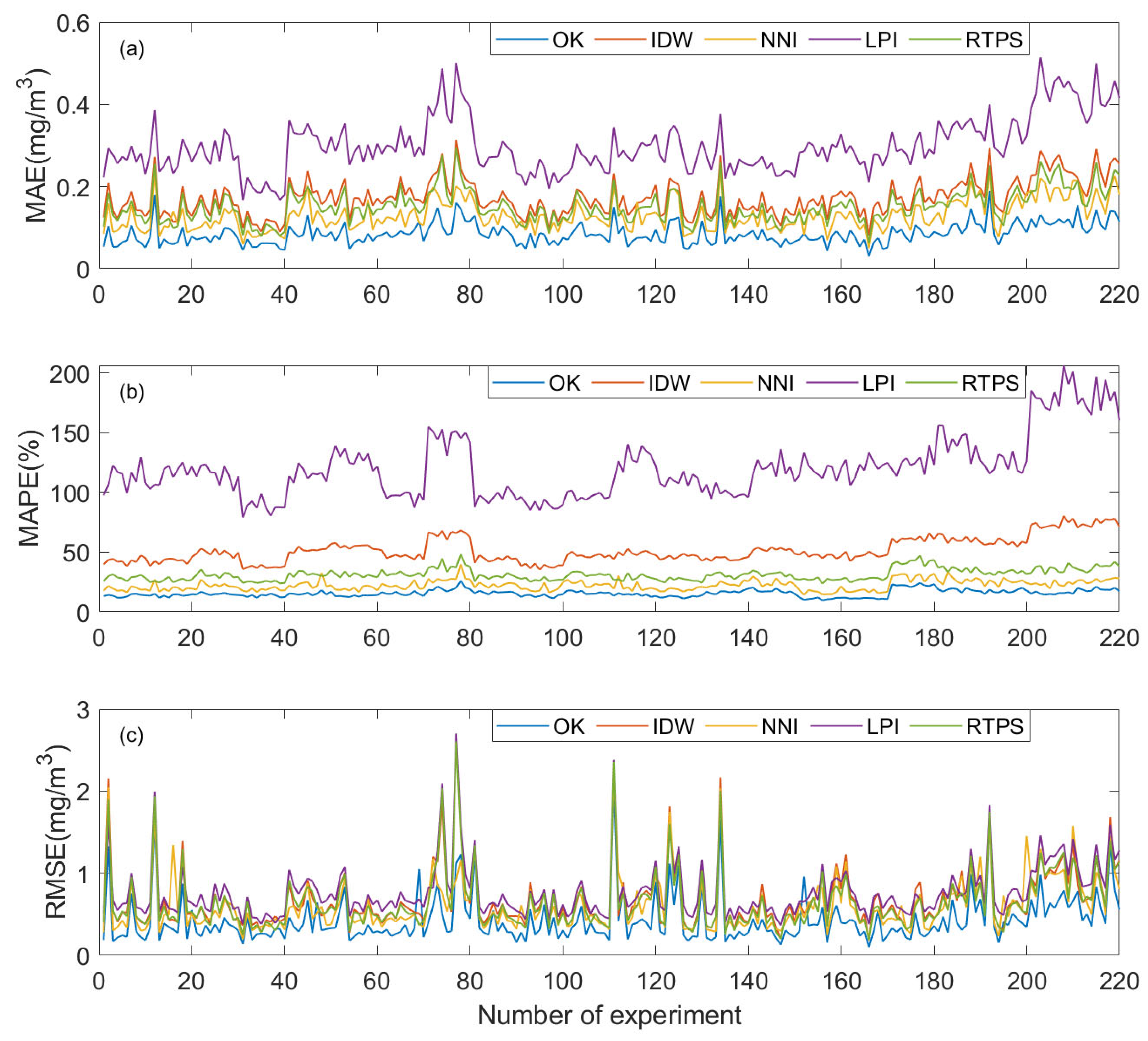
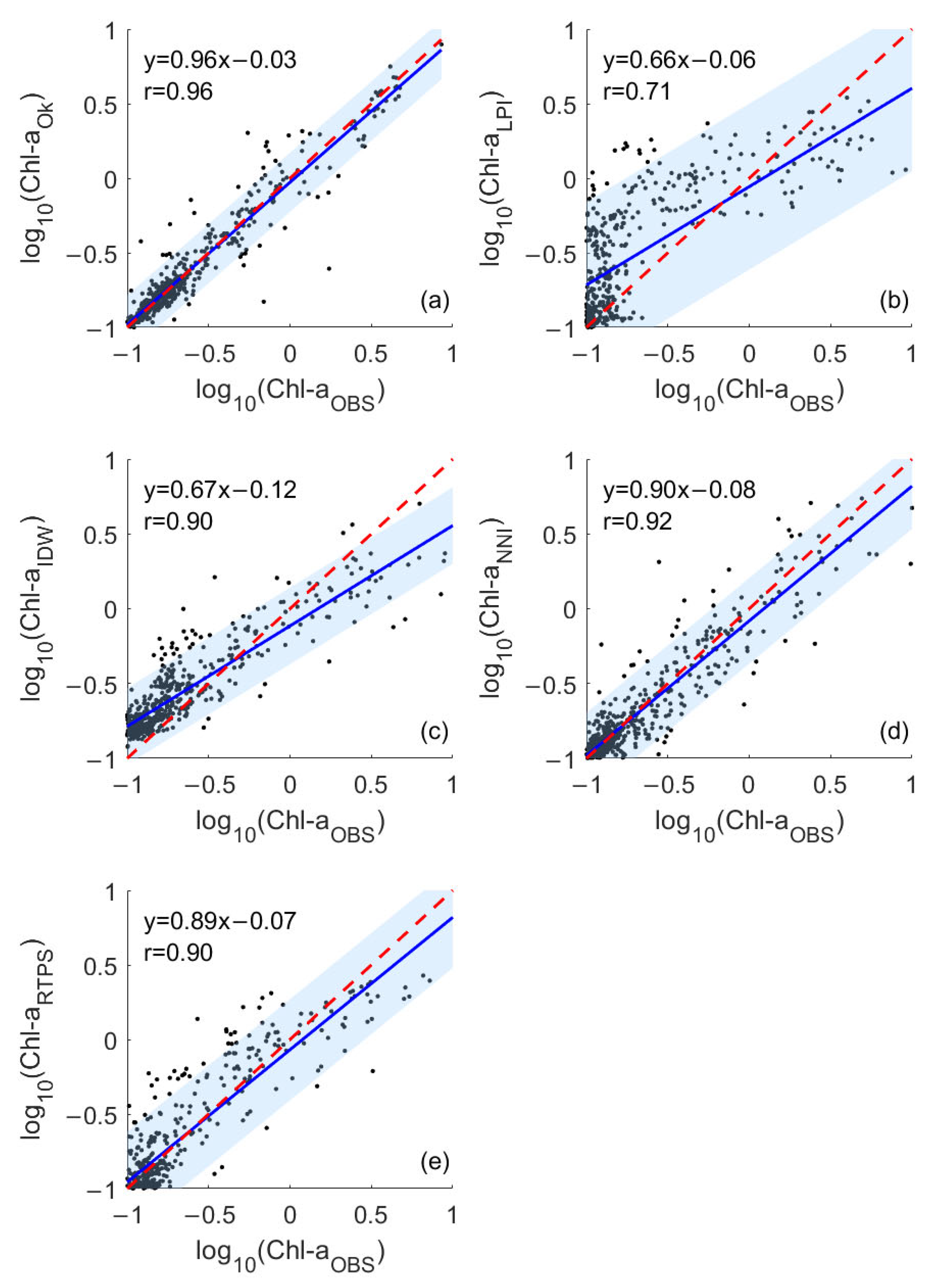
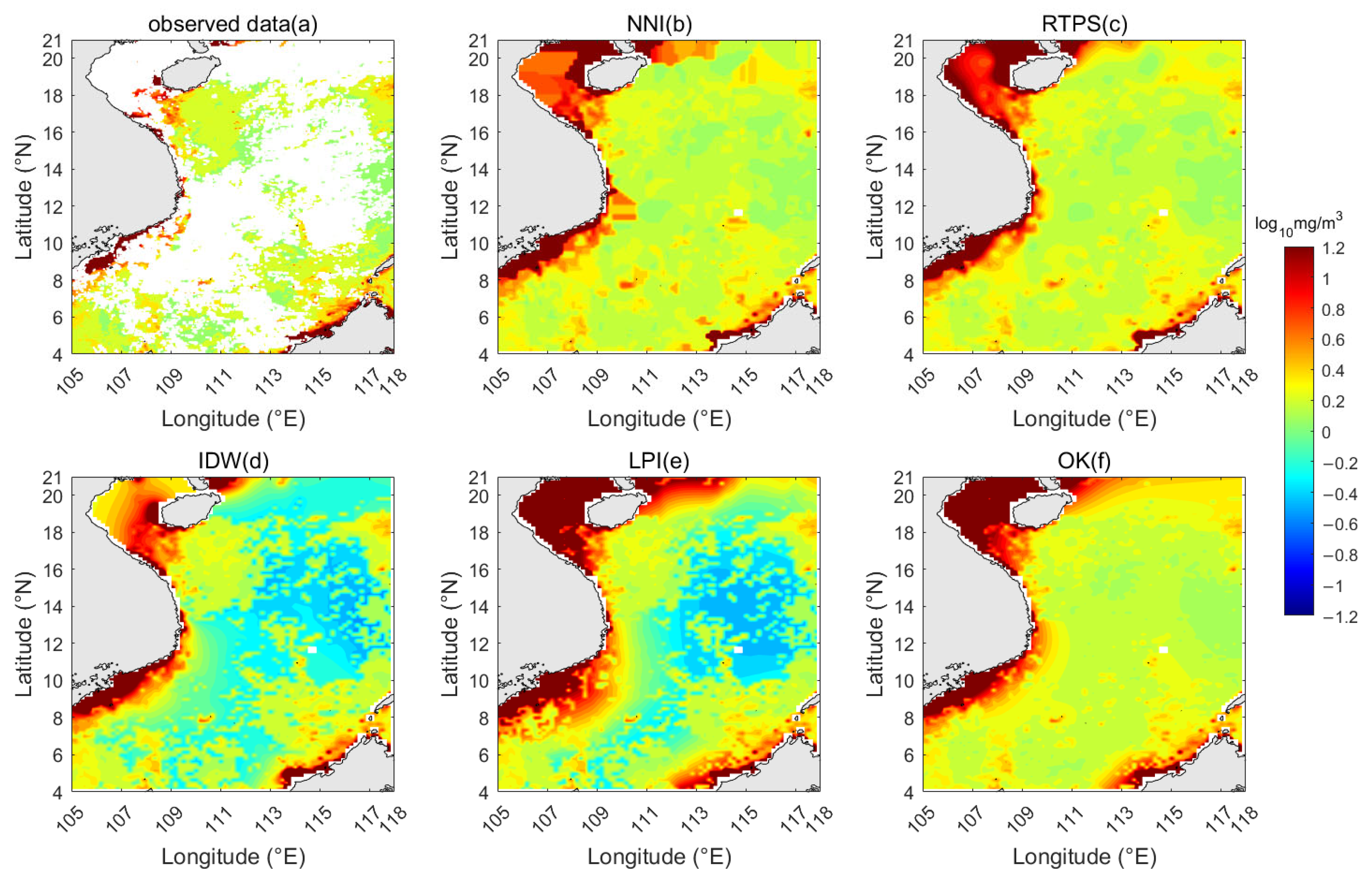
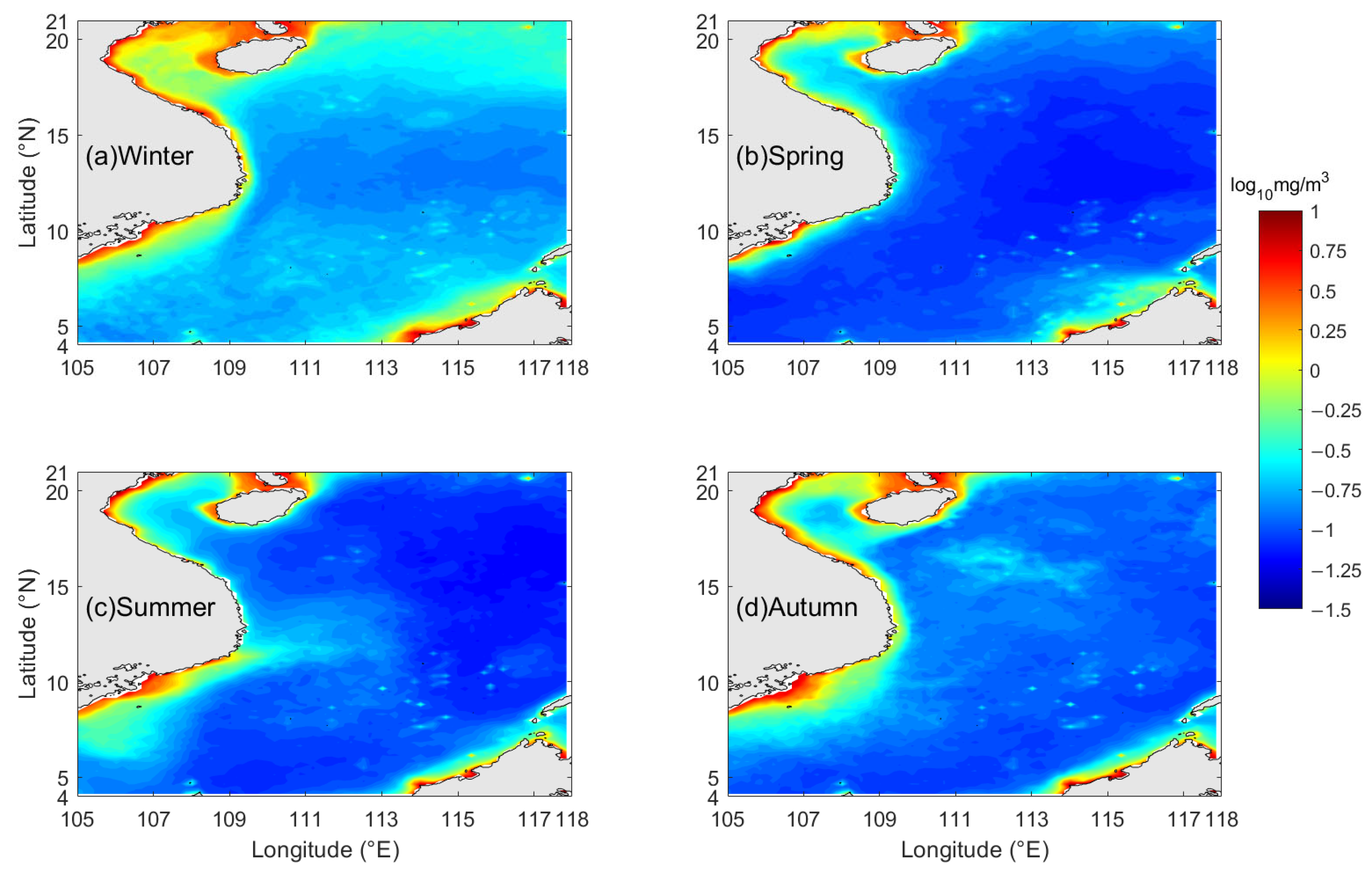
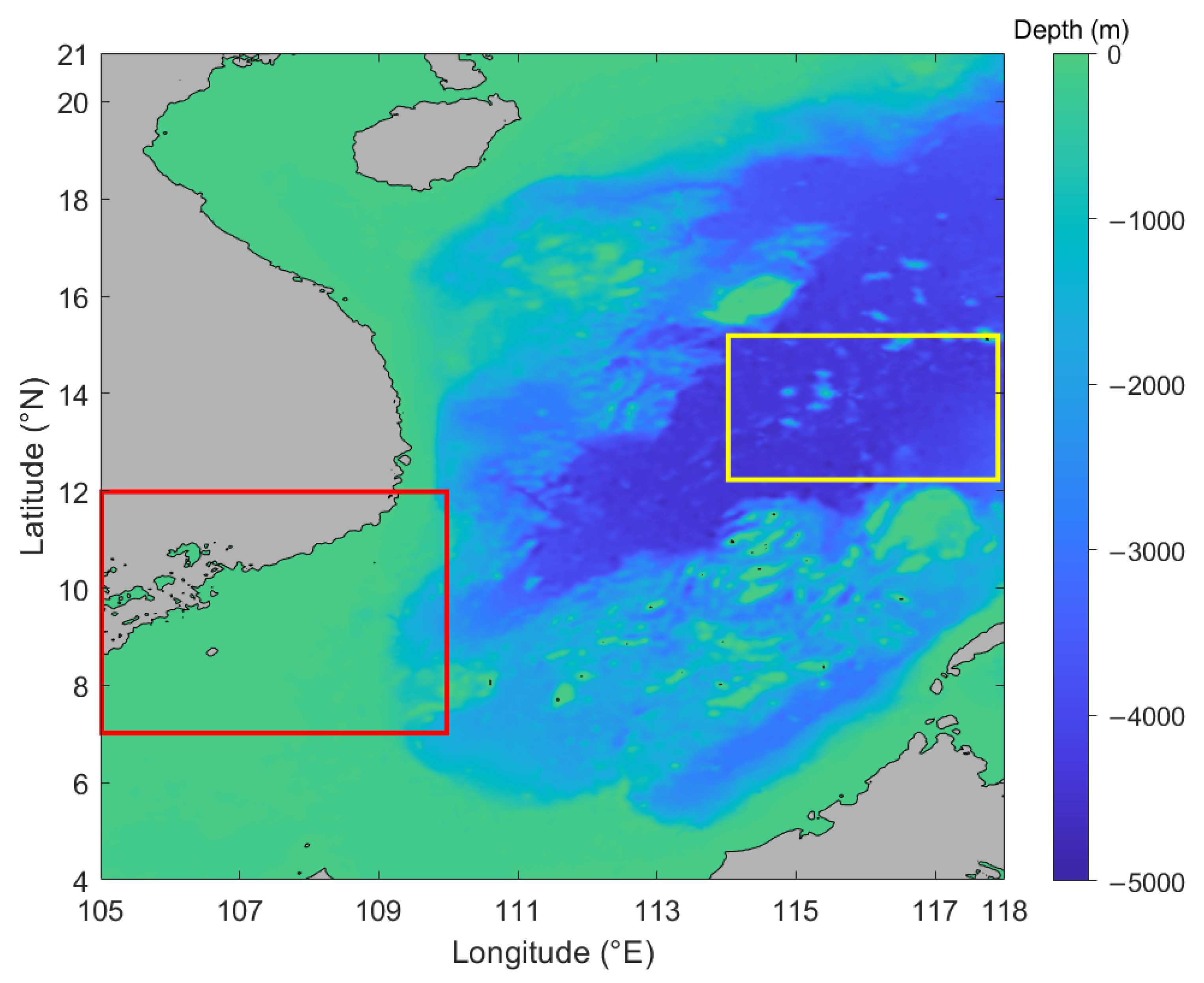
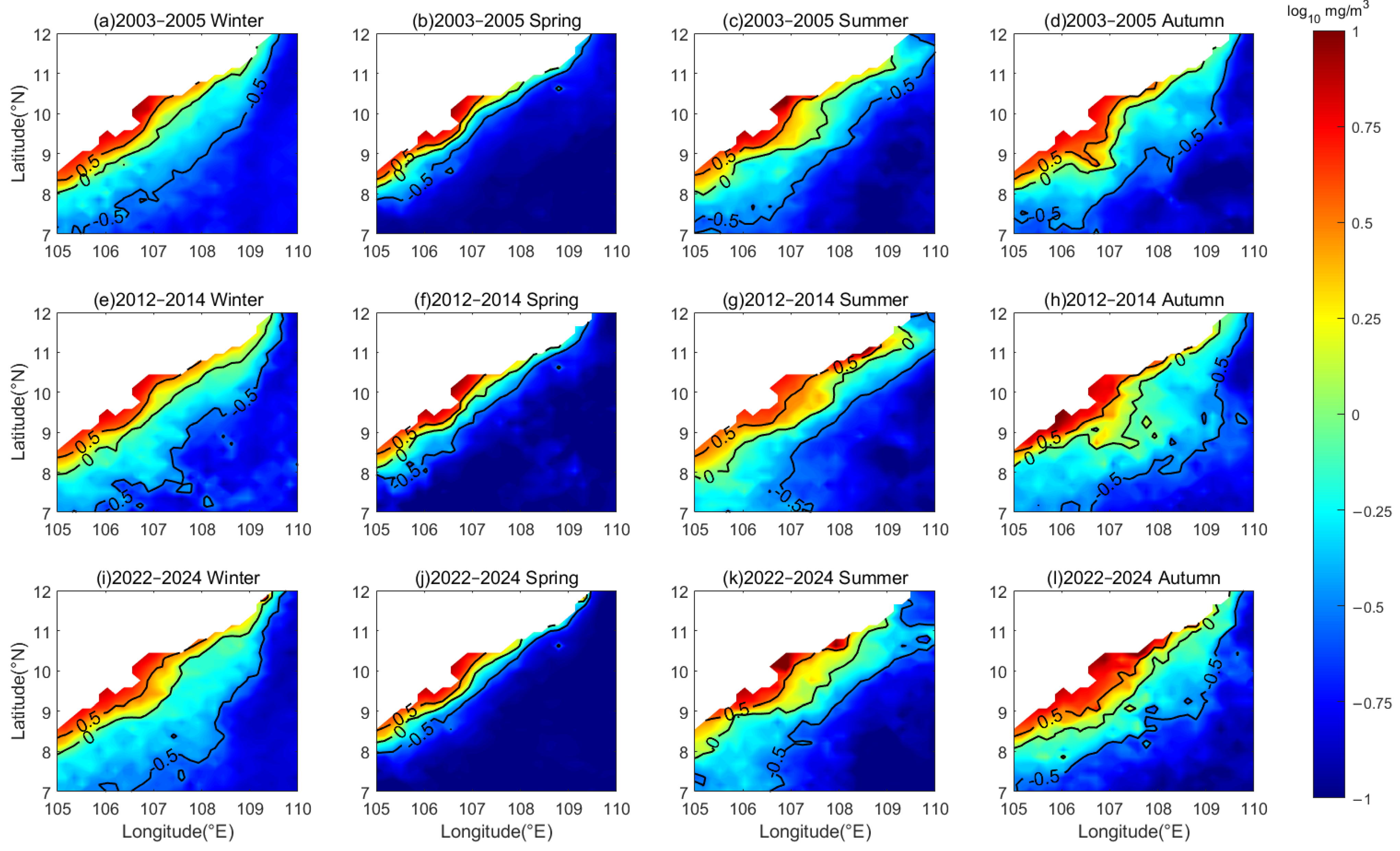
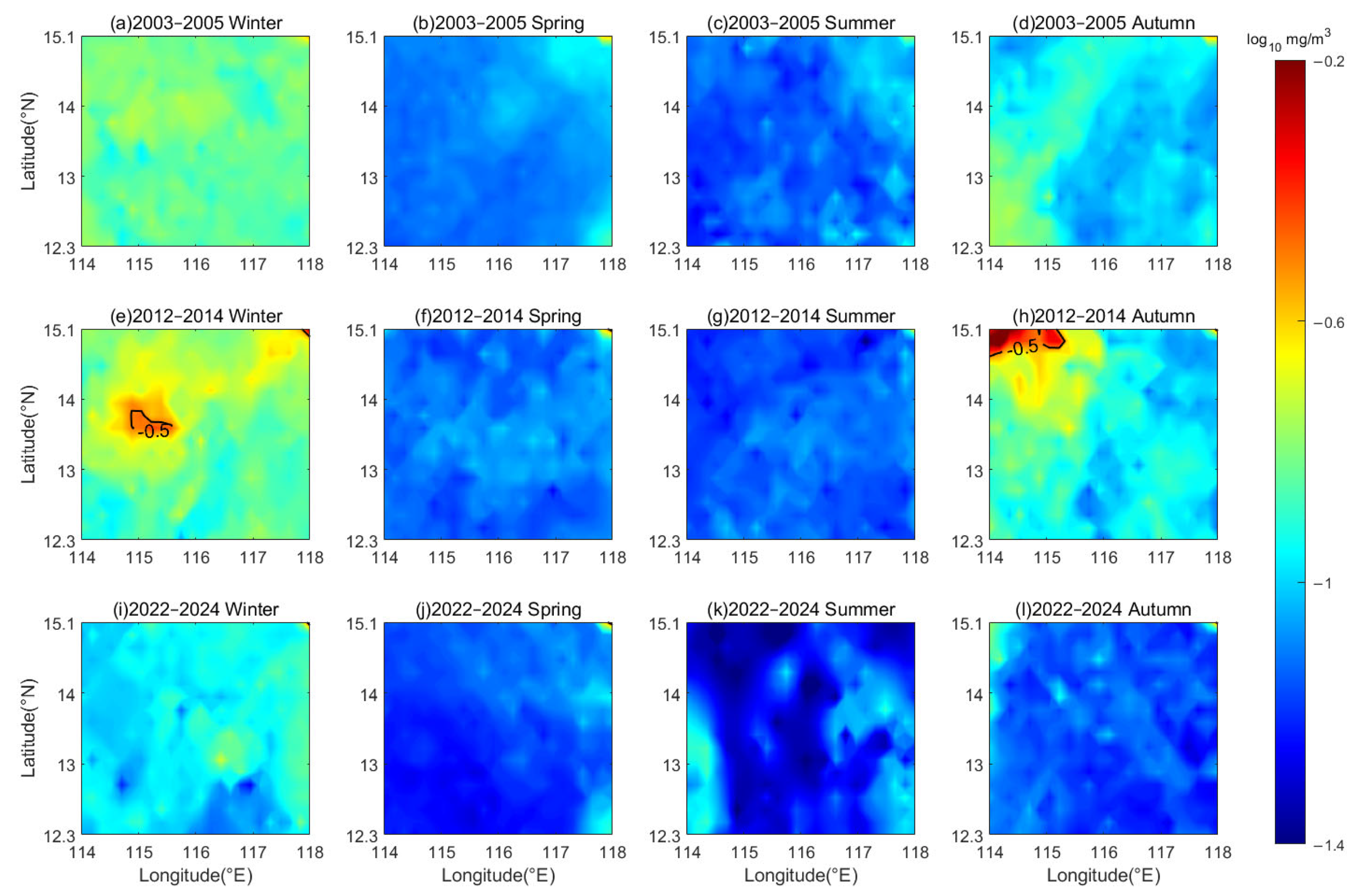
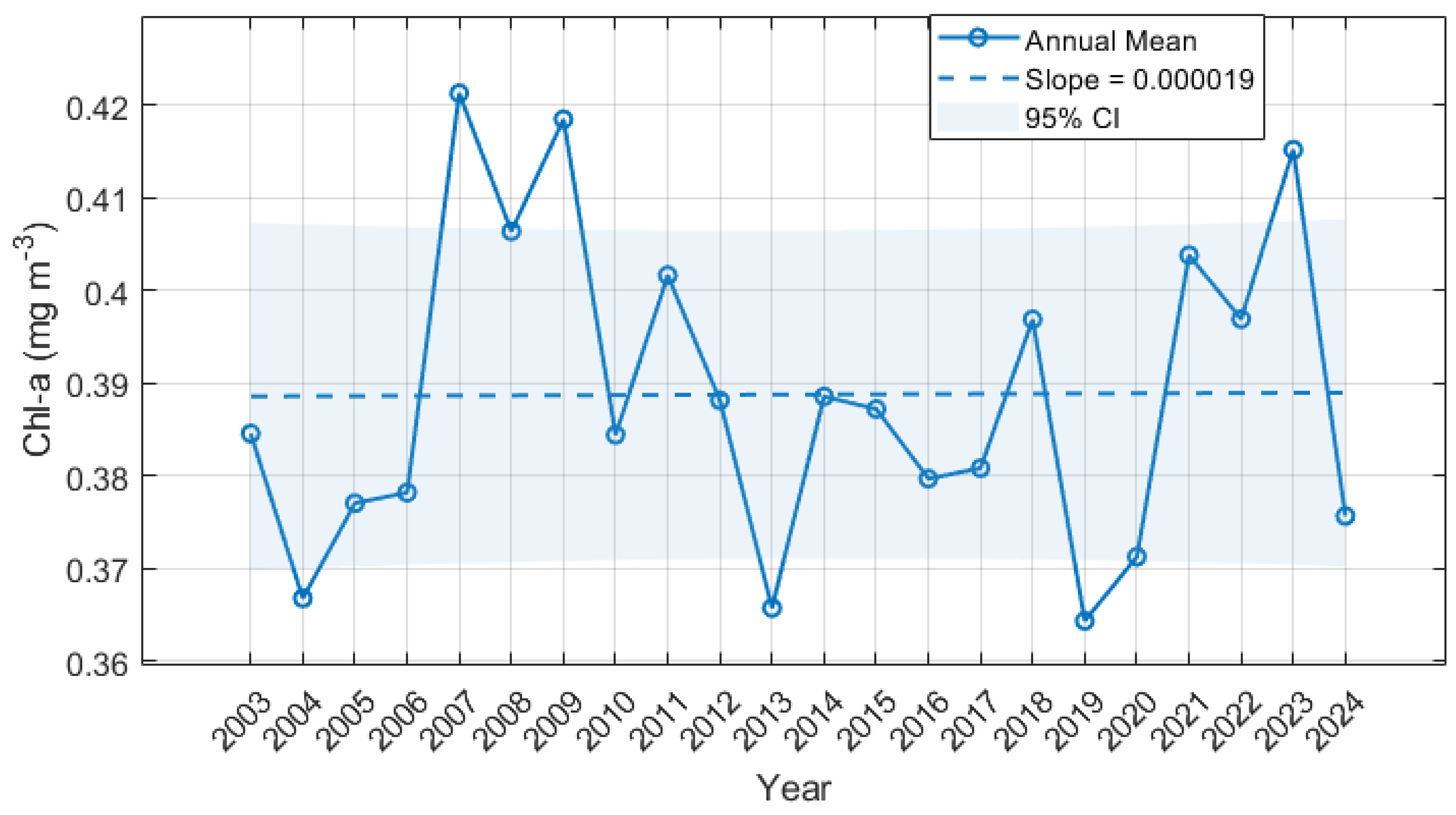
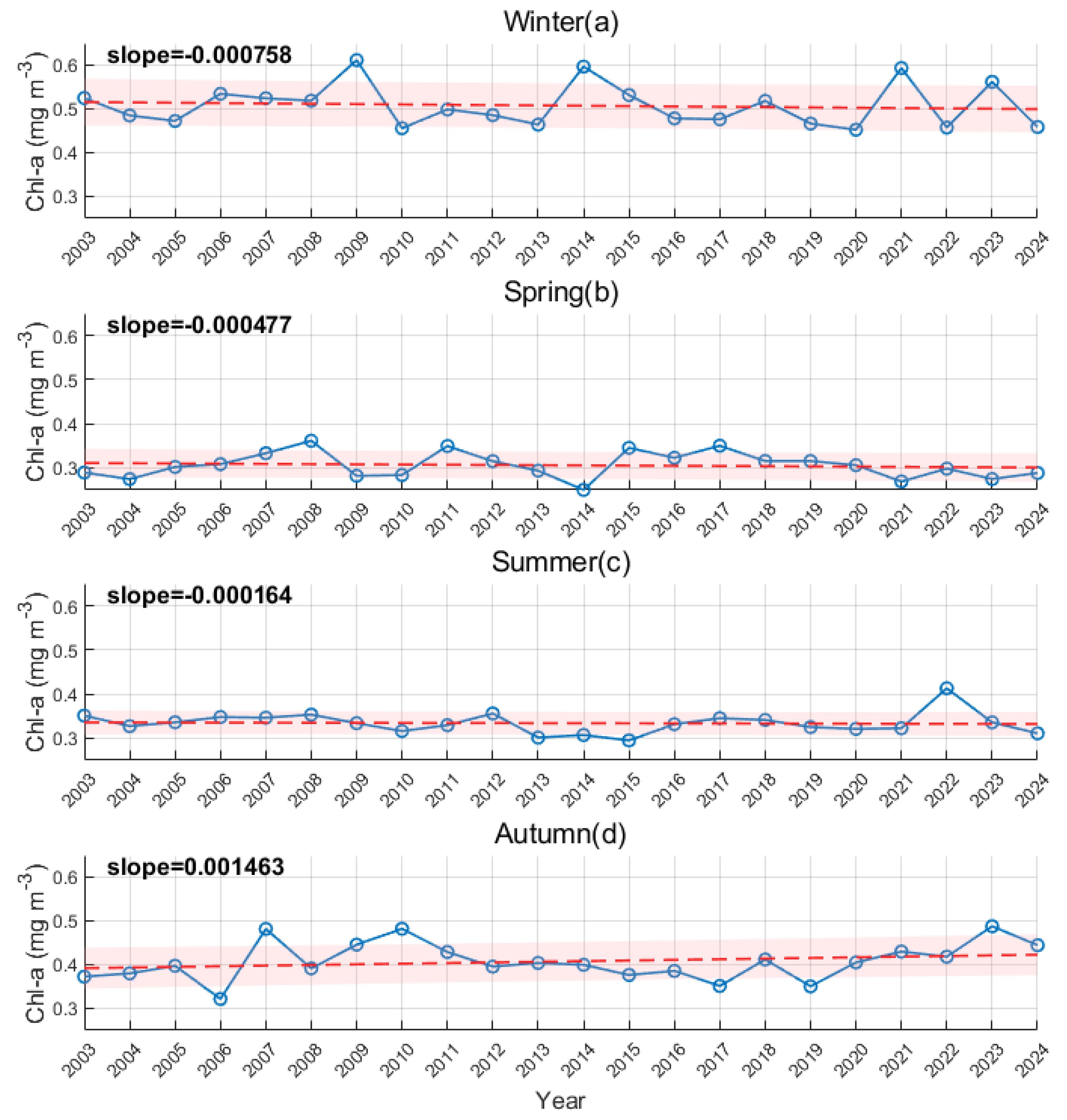
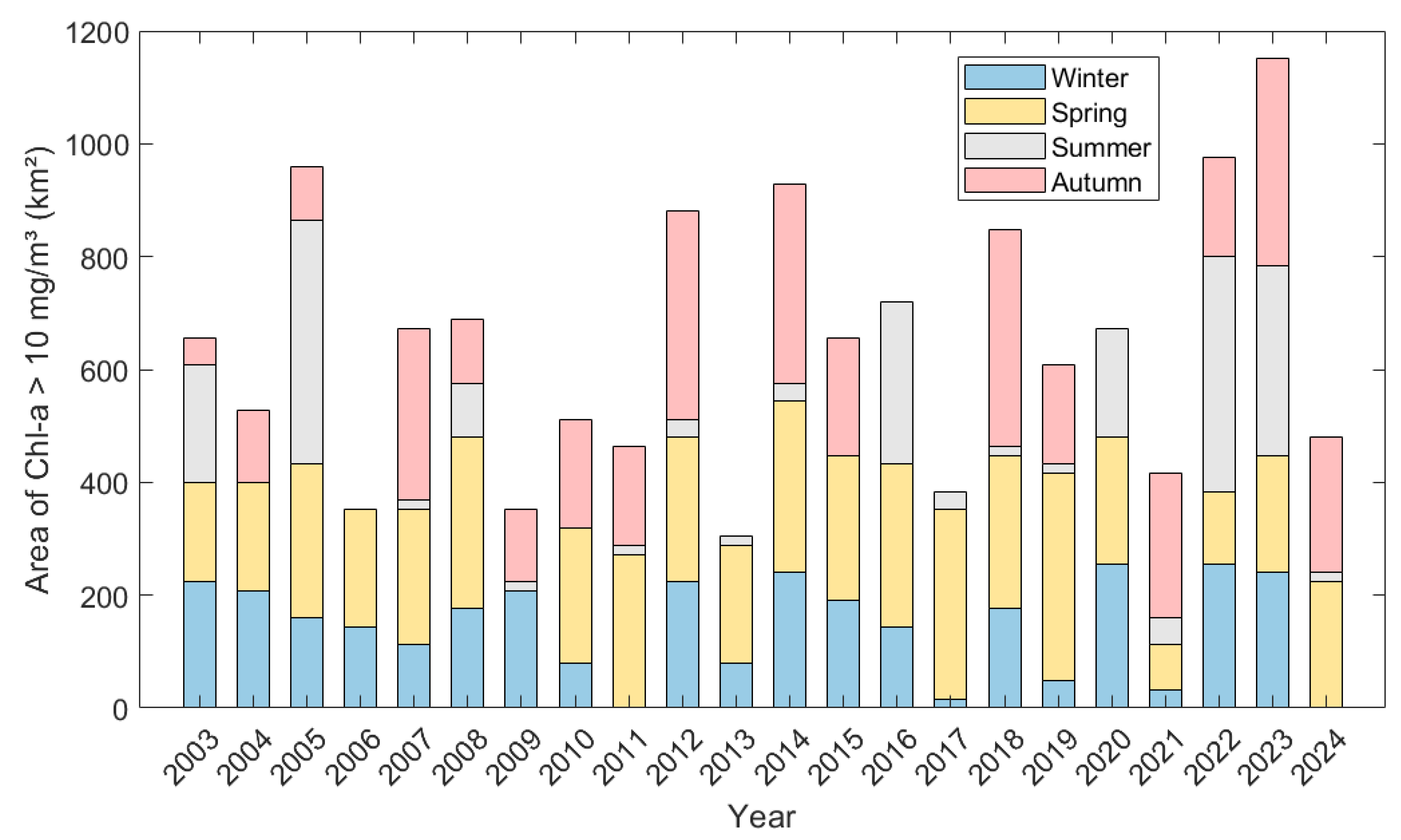
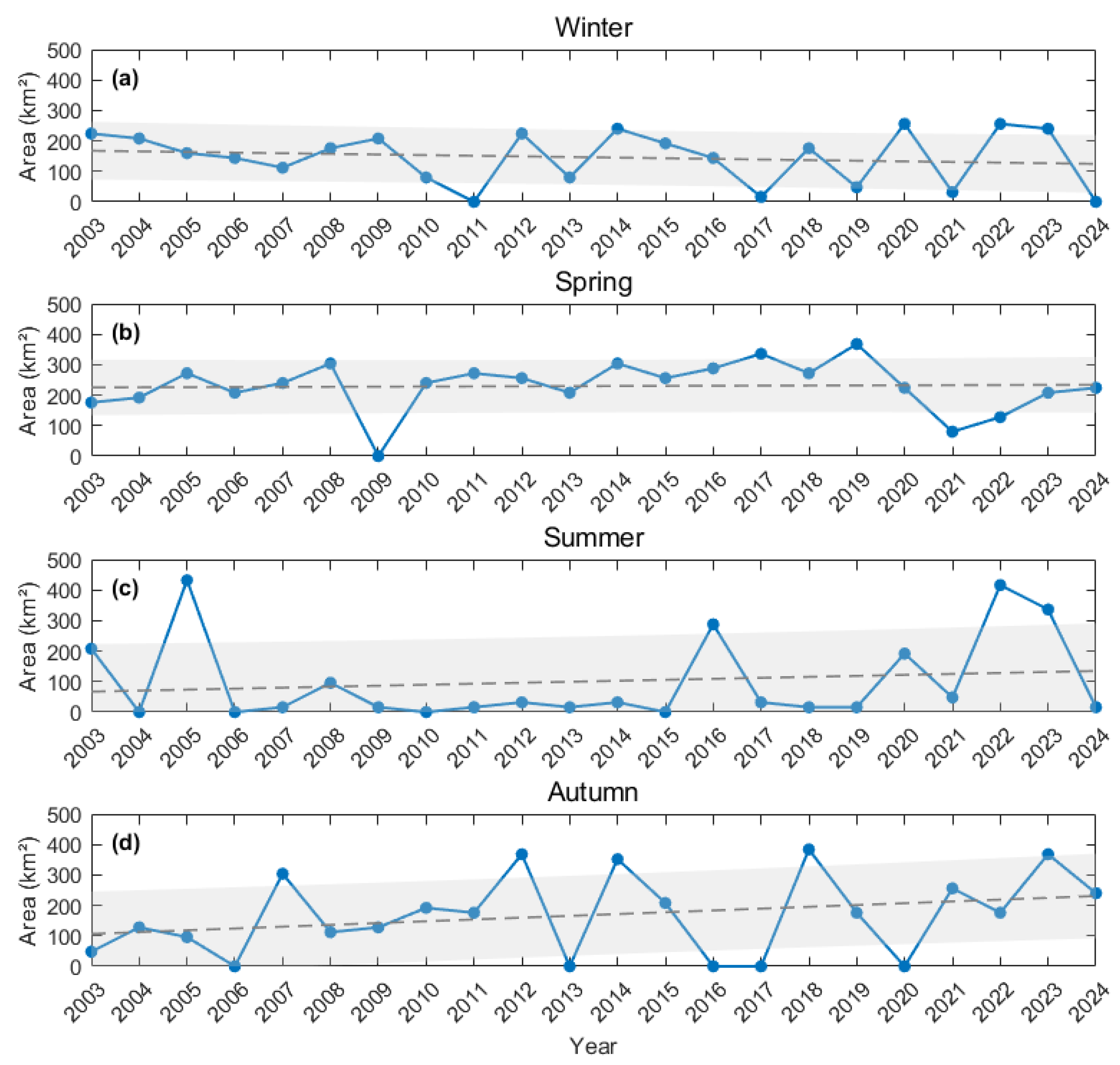
| Chlorophyll-a | |||
|---|---|---|---|
| Methods | MAE (mg/m3) | MAPE (%) | RMSE (mg/m3) |
| OK | 0.09 | 16 | 0.43 |
| IDW | 0.17 | 52 | 0.68 |
| NNI | 0.13 | 22 | 0.62 |
| LPI | 0.30 | 120 | 0.77 |
| RTPS | 0.15 | 31 | 0.65 |
Disclaimer/Publisher’s Note: The statements, opinions and data contained in all publications are solely those of the individual author(s) and contributor(s) and not of MDPI and/or the editor(s). MDPI and/or the editor(s) disclaim responsibility for any injury to people or property resulting from any ideas, methods, instructions or products referred to in the content. |
© 2025 by the authors. Licensee MDPI, Basel, Switzerland. This article is an open access article distributed under the terms and conditions of the Creative Commons Attribution (CC BY) license (https://creativecommons.org/licenses/by/4.0/).
Share and Cite
Wu, J.; Jiang, D.; Cai, Z.; Lv, J.; Liu, G.; Li, B. Eutrophication Assessment Revealed by the Distribution of Chlorophyll-a in the South China Sea. Remote Sens. 2025, 17, 3388. https://doi.org/10.3390/rs17193388
Wu J, Jiang D, Cai Z, Lv J, Liu G, Li B. Eutrophication Assessment Revealed by the Distribution of Chlorophyll-a in the South China Sea. Remote Sensing. 2025; 17(19):3388. https://doi.org/10.3390/rs17193388
Chicago/Turabian StyleWu, Jingwen, Dong Jiang, Zhichao Cai, Jing Lv, Guowei Liu, and Bingtian Li. 2025. "Eutrophication Assessment Revealed by the Distribution of Chlorophyll-a in the South China Sea" Remote Sensing 17, no. 19: 3388. https://doi.org/10.3390/rs17193388
APA StyleWu, J., Jiang, D., Cai, Z., Lv, J., Liu, G., & Li, B. (2025). Eutrophication Assessment Revealed by the Distribution of Chlorophyll-a in the South China Sea. Remote Sensing, 17(19), 3388. https://doi.org/10.3390/rs17193388





